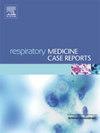Effects of preoperative veno-venous extracorporeal membrane oxygenation management and left atrial pressure reduction via balloon atrial septostomy on respiratory system compliance in a neonate with transposition of the great arteries with intact ventricular septum
IF 0.8
Q4 RESPIRATORY SYSTEM
引用次数: 0
Abstract
Background
Transposition of the great arteries with intact ventricular septum causes severe hypoxia immediately after birth. Balloon atrial septostomy is often required for oxygenation improvement, and severe cases may require veno-venous extracorporeal membrane oxygenation (VV-ECMO). This case report highlights the critical role of balloon atrial septostomy in improving respiratory system compliance and facilitating early ECMO discontinuation in a neonate with transposition of the great arteries.
Case summary
A neonate with transposition of the great arteries experienced persistent hypoxia, hypotension, and lactic acidosis, prompting VV-ECMO on the first day of life. Echocardiography revealed a restrictive atrial septal defect, and balloon atrial septostomy was performed. This resulted in increased oxygen saturation, improved respiratory system compliance (from 0.19 to 0.43 mL/cmH2O/kg), and reduced left atrial pressure. ECMO was successfully withdrawn on day 2, which was later followed by a successful Jatene procedure.
Conclusion
Balloon atrial septostomy can significantly improve oxygenation and respiratory system compliance in patients with transposition of the great arteries, enabling rapid VV-ECMO discontinuation and informing future congenital heart disease management.
术前静脉-静脉体外膜氧合处理及球囊房间隔造口左房压降低对完全性室间隔大动脉转位新生儿呼吸系统顺应性的影响
背景:大动脉转位与完整的室间隔导致出生后立即严重缺氧。气囊房间隔造口术通常需要改善氧合,严重者可能需要静脉-静脉体外膜氧合(VV-ECMO)。本病例报告强调了球囊房间隔造口术在改善呼吸系统顺应性和促进大动脉转位新生儿早期ECMO中止中的关键作用。1例大动脉转位新生儿出现持续性缺氧、低血压和乳酸性酸中毒,提示在出生第一天进行VV-ECMO。超声心动图显示限制性房间隔缺损,并进行球囊房间隔造口术。这导致血氧饱和度升高,呼吸系统顺应性改善(从0.19 mL/cmH2O/kg降至0.43 mL/cmH2O/kg),左房压降低。ECMO于第2天成功取出,随后进行了成功的Jatene手术。结论球囊房间隔造口术可显著改善大动脉转位患者的氧合和呼吸系统顺应性,可快速终止VV-ECMO,为今后先天性心脏病的治疗提供参考。
本文章由计算机程序翻译,如有差异,请以英文原文为准。
求助全文
约1分钟内获得全文
求助全文
来源期刊

Respiratory Medicine Case Reports
RESPIRATORY SYSTEM-
CiteScore
2.10
自引率
0.00%
发文量
213
审稿时长
87 days
 求助内容:
求助内容: 应助结果提醒方式:
应助结果提醒方式:


